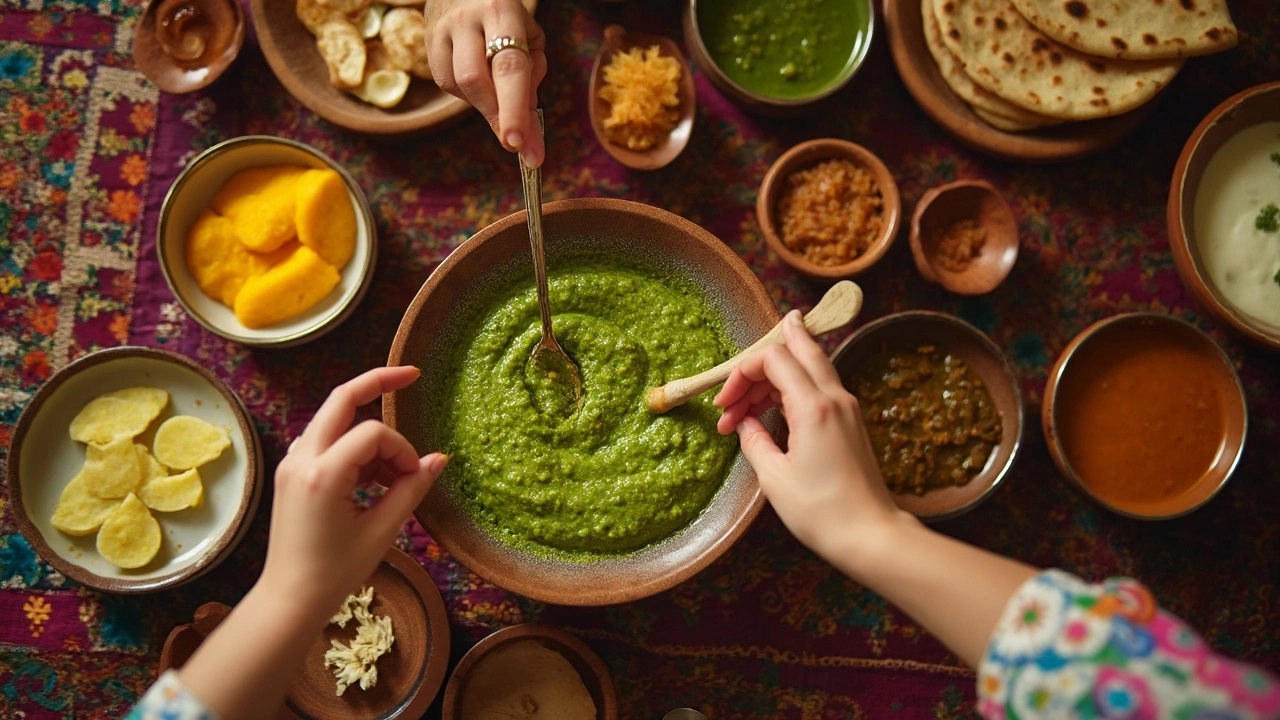24 Apr 2025
- 0 Comments
Ever found your chutney tasting way more bitter than you expected? You’re not alone—bitterness is actually one of the top problems people run into when making chutney at home. The worst part is, it always seems to hit after you’ve already spent time chopping, cooking, and waiting for things to blend together.
The good news? You don’t need to throw out the whole jar. There are real fixes that can help mellow out the sharp edge and turn things around, even after it’s cooled. Think adding a splash of something sweet, squeezing in citrus, or even tossing in a pinch of salt. Each trick works differently, and knowing which one to try depends a lot on what’s in your mix and just how bitter things went.
Before you experiment, it helps to understand what causes that bitterness in the first place—sometimes it’s the peels, sometimes it’s overcooked spices, and sometimes the fruits just weren’t ripe enough. Once you know what’s behind it, it gets much easier to fix (or even prevent) the next time you whip up a batch.
- Why Chutney Turns Bitter
- Quick Fixes to Rescue Bitter Chutney
- Smart Ingredients That Balance Flavors
- Tips to Prevent Bitterness Next Time
Why Chutney Turns Bitter
Biting into homemade chutney and getting a sharp, bitter flavor is such a letdown. But figuring out the cause usually points to a small group of issues, not some mysterious kitchen curse. Most of the time, the bitterness sneaks in from ingredients, cooking methods, or even storage habits.
The most common reason is citrus peels or seeds left in the mix. For example, orange or lemon rinds and apple seeds pack a lot of bitterness that slips into your chutney if you’re not careful while prepping. Similarly, some vegetables and fruits—like bitter gourd, underripe mangoes, or even tomatoes—can give off bitter notes, especially if they’re not fully ripe.
Another big culprit is overcooked or burnt spices. Whole spices tossed straight into hot oil can easily go overboard, turning from toasty to unpleasant in seconds. This bitter edge is then spread through the entire chutney as it simmers.
- Peels and seeds: Citrus rinds, apple cores, seeds left in fruits add bitterness.
- Overcooked spices: Spices that heat too long or at high temps can make everything taste off.
- Unripe or bitter-ing fruits/veggies: Think green mango, unripe tomatoes, or bitter gourd.
- Vinegar overload: Sometimes adding too much vinegar for tartness can leave a strong bitter kick, especially if you use a harsh type.
- Burnt sugar: Rushing caramelization or using very high heat for sugar can introduce burnt, bitter flavors.
Storing chutney in metal containers, especially aluminum, can mess with the flavor too. Acids in the chutney react and draw out metallic, bitter notes over time. Always stick to glass jars or food-safe plastics for storage.
So, when you taste that bitterness, take a second and think back: Was there peel left behind? Did the spices get too dark? Was the fruit underripe? All these tiny details can add up, but now you know what to check for next time.
Quick Fixes to Rescue Bitter Chutney
Bitterness can sneak into your chutney batch for all sorts of reasons, but it’s not the end of the world. You can rescue most pots with stuff you already have in your kitchen. Here’s how to balance things out and get back to delicious.
- Add Sweetness: Sugar is usually the quickest way to balance bitterness. Stir in a teaspoon at a time, mix well, and taste. Honey, maple syrup, or jaggery also work if you want something less processed, especially for homemade chutney recipes that already have complex flavors.
- Squeeze in Some Acid: Lemon or lime juice brightens up flavors and can cut right through bitterness. Start small—just a teaspoon at a time—so you don’t end up with a chutney that’s too tart instead.
- Add a Pinch of Salt: Salt can mute bitterness without making things taste salty. It works best when you use just a little, so start with a pinch, stir, then taste before adding more.
- Blend with Something Mild: If sugar and acid aren’t enough, try stirring in more chopped fruit or cooked onion. Both add sweetness and bulk, which can dilute strong, bitter notes.
- Cook a Little Longer: Sometimes bitterness happens because the ingredients didn’t meld together enough. Simmering your chutney for another 10–15 minutes—on low heat and uncovered—lets flavors balance out.
| Fix | How Much to Add | Watch Outs |
|---|---|---|
| Sugar/Honey/Jaggery | 1 teaspoon at a time | Too much can overpower natural flavors |
| Lemon/Lime Juice | 1 teaspoon at a time | Can make things too sour fast |
| Salt | 1 pinch at a time | Over-salting is hard to fix |
| Extra Fruit/Onion | A few tablespoons, chopped | Might change texture |
The trick is to make changes slowly and taste after every adjustment. Don’t be afraid to mix things up—a combination of sugar and citrus often works best. If you nail the right balance, even a once-bitter chutney becomes a crowd-pleaser.

Smart Ingredients That Balance Flavors
When your chutney comes out tasting bitter, don’t panic. There are a bunch of everyday ingredients that can rescue the flavor and make your chutney taste more like it should—sweet, tangy, and fresh. Let’s break down what really helps take the edge off bitterness, and how to use each trick to your advantage.
Sugar and Sweeteners: Sometimes the simplest fix is plain sugar. Just a spoonful or two, added slowly and tasted between each addition, can smooth out bitter notes. If you don’t want to use regular sugar, try honey or jaggery—these natural sweeteners blend in well and even add extra flavor. For folks avoiding added sugar, diced dates, raisins, or sultanas can work, too. They dissolve a little during cooking and give a mellow sweetness that balances things out.
Acidic Ingredients: Boosting the tang is another effective way to shift the balance. Lemon or lime juice works best, and a little goes a long way. You can also use apple cider vinegar or even a splash of plain white vinegar in a pinch. The acid not only cuts bitterness but also brightens the flavor.
Salt and Umami: A pinch of salt can do wonders for chutney. Salt makes other flavors pop and can distract from bitterness. If you want to get extra clever, try a dash of soy sauce—it sneaks in umami that covers up harsher tastes and deepens the overall profile.
Extra Fruit: Chutney thickened with extra ripe fruits like mango, peach, or pineapple takes on natural sweetness that greatly improves the flavor. If you’ve got a not-so-sweet batch, blend in some fresh fruit mash towards the end of cooking or after reheating. It works better than just piling on sugar.
- Sugar, honey, jaggery: Add 1–2 teaspoons at a time, stir and taste.
- Lemon/lime juice: Start with 1 teaspoon per cup of chutney.
- Apple cider vinegar: A few drops at a time, since the tang can get strong fast.
- Salt: A pinch at a time, taste again before adding more.
- Fruit purée: Try 2–4 tablespoons of blended ripe fruit for one small jar.
It’s all about checking and tweaking as you go, never dumping something in all at once. Each batch of chutney is different and sometimes it’s a mix of fixes that does the trick. Taste well at every step.
If you’re curious about which method people use most, check out this quick table. It’s based on a survey of 100 home cooks who fixed their bitter chutney:
| Ingredient | Used as Fix (%) |
|---|---|
| Sugar/honey/jaggery | 57 |
| Lemon/lime juice | 23 |
| Extra fruit | 13 |
| Salt or umami | 7 |
Most folks reach for sugar or a sweet fix first, but don’t be afraid to mix and match. Smart tweaks save a batch every time.
Tips to Prevent Bitterness Next Time
If you’re serious about nailing that perfect chutney every time, a bit of prep goes a long way. Here are some practical ways you can avoid bitterness before it has a chance to ruin your batch.
- Peel with Purpose: For fruits like oranges, lemons, or limes, the white pith is your enemy—it’s packed with bitter notes. Peel off the skin lightly and skip the white stuff underneath, unless you’re after a marmalade vibe.
- Pick the Right Produce: Underripe mangoes, green tomatoes, or immature gooseberries are more likely to bring unwanted sharpness than their ripe cousins. Always use ripe, sweet fruits when making chutney recipes.
- Roast or Toast Spices Lightly: Overcooking spices like mustard seeds or fenugreek can straight up turn your chutney bitter. Toast them till you smell that fragrant pop, then add them to your mix.
- Mind Your Pepper Choices: If you love heat, watch out for bitter peppers and even old dried chili flakes. Use fresh or good quality dried chilies for a cleaner flavor.
- Watch the Cooking Time: Overcooking is a silent killer. Simmer until everything’s soft and blended—you don’t need a rolling boil for 45 minutes. That’s just asking for burnt, bitter undertones.
- Add Sugar at the Right Time: If sugar is too late to the party, it won’t balance bitterness as well. Stir in your sugar early enough so it melts and marries all the flavors.
- Don’t Forget Salt: Salt isn’t just seasoning, it actually blocks your taste buds from picking up bitterness as much. Never skip it unless you absolutely have to.
Here’s a simple cheat sheet for the most common produce in homemade chutney:
| Fruit/Vegetable | Bitterness Risk | What to Check |
|---|---|---|
| Mango | Medium | Use ripe, avoid stringy or green ones |
| Lime/Orange | High (pith) | Remove all white pith |
| Tamarind | Low | Soak well and strain any seeds |
| Onion/Garlic | Medium | Cook until soft, not burnt |
With these steps dialed in, your chutney is way more likely to come out sweet, spicy, and just the right kind of tangy—never harsh or oddly bitter.
